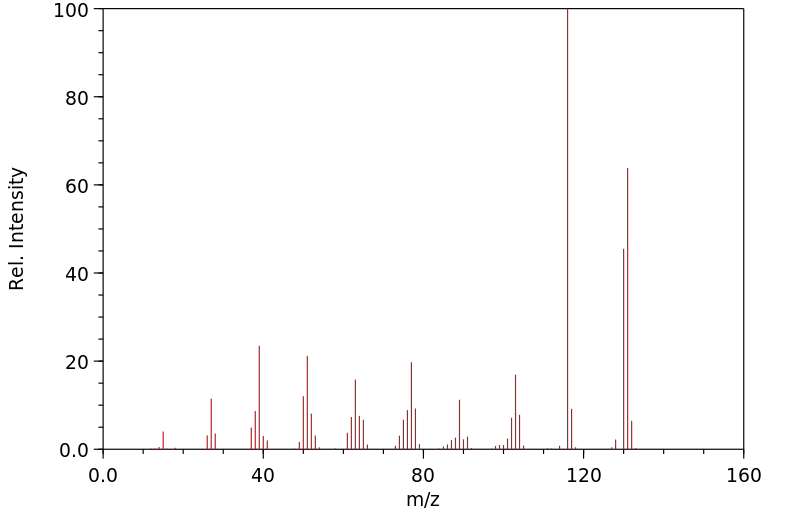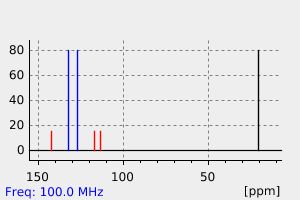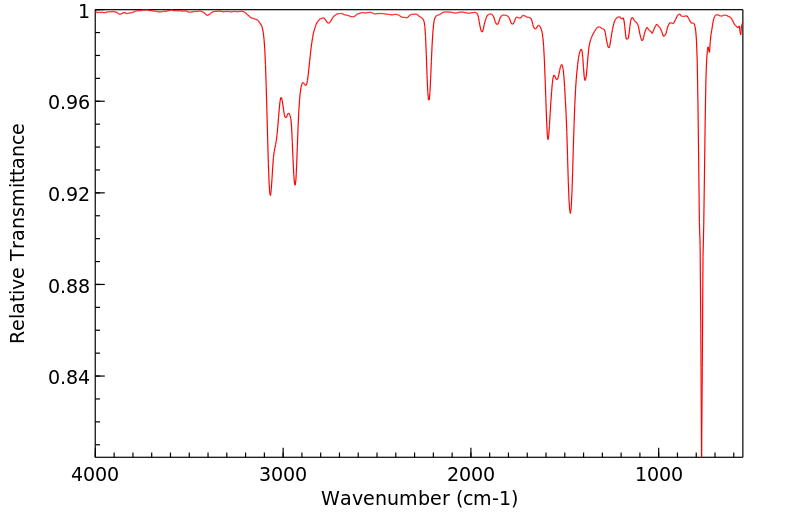2, 6-二甲基苄氰 | 6575-13-9
中文名称
2, 6-二甲基苄氰
中文别名
2,6-二甲基苯甲腈;2,6-二甲基苄氰;2,6-二甲基苄氰;2,6-二甲基苯腈;2, 6-二甲基苄氰
英文名称
2,6-dimethylbenzonitrile
英文别名
——
CAS
6575-13-9
化学式
C9H9N
mdl
——
分子量
131.177
InChiKey
QSACPWSIIRFHHR-UHFFFAOYSA-N
BEILSTEIN
——
EINECS
——
-
物化性质
-
计算性质
-
ADMET
-
安全信息
-
SDS
-
制备方法与用途
-
上下游信息
-
文献信息
-
表征谱图
-
同类化合物
-
相关功能分类
-
相关结构分类
物化性质
-
熔点:88-91 °C
-
沸点:93°C/10mmHg(lit.)
-
密度:1.0111 (estimate)
-
最大波长(λmax):231nm(EtOH)(lit.)
-
稳定性/保质期:
存在于烟气中。
计算性质
-
辛醇/水分配系数(LogP):2.4
-
重原子数:10
-
可旋转键数:0
-
环数:1.0
-
sp3杂化的碳原子比例:0.22
-
拓扑面积:23.8
-
氢给体数:0
-
氢受体数:1
安全信息
-
危险等级:6.1
-
危险品标志:Xn
-
安全说明:S26,S36/37/39
-
危险类别码:R20/21/22
-
海关编码:2926909090
-
危险品运输编号:3439
-
包装等级:III
-
危险类别:6.1
-
危险性防范说明:P261,P305+P351+P338
-
危险性描述:H302,H315,H319,H335
-
储存条件:| 室温 |
SDS
| Name: | 2 6-Dimethylbenzonitrile Material Safety Data Sheet |
| Synonym: | None Known |
| CAS: | 6575-13-9 |
Synonym:None Known
Section 2 - COMPOSITION, INFORMATION ON INGREDIENTS
| CAS# | Chemical Name | content | EINECS# |
| 6575-13-9 | 2,6-Dimethylbenzonitrile | 99% | 229-503-5 |
Risk Phrases: 20/21/22
Section 3 - HAZARDS IDENTIFICATION
EMERGENCY OVERVIEW
Harmful by inhalation, in contact with skin and if swallowed.The toxicological properties of this material have not been fully investigated.
Potential Health Effects
Eye:
May cause eye irritation.
Skin:
May cause skin irritation. Harmful if absorbed through the skin. May be metabolized to cyanide which in turn acts by inhibiting cytochrome oxidase impairing cellular respiration.
Ingestion:
Harmful if swallowed. May cause irritation of the digestive tract.
The toxicological properties of this substance have not been fully investigated. Metabolism may release cyanide, which may result in headache, dizziness, weakness, collapse, unconsciousness and possible death.
Inhalation:
Harmful if inhaled. May cause respiratory tract irritation. The toxicological properties of this substance have not been fully investigated. May be metabolized to cyanide which in turns act by inhibiting cytochrome oxidase impairing cellular respiration.
Chronic:
Chronic exposure to cyanide solutions may lead to the development of a "cyanide" rash, characterized by itching, and by macular, papular, and vesicular eruptions, and may be accompanied by secondary infections. Exposure to small amounts of cyanide compounds over long periods of time is reported to cause loss of appetite, headache, weakness, nausea, dizziness, and symptoms of irritation of the upper respiratory tract and eyes.
Section 4 - FIRST AID MEASURES
Eyes: In case of contact, immediately flush eyes with plenty of water for at least 15 minutes. Get medical aid.
Skin:
In case of contact, flush skin with plenty of water. Remove contaminated clothing and shoes. Get medical aid if irritation develops and persists. Wash clothing before reuse.
Ingestion:
If swallowed, do not induce vomiting unless directed to do so by medical personnel. Never give anything by mouth to an unconscious person. Get medical aid.
Inhalation:
If inhaled, remove to fresh air. If not breathing, give artificial respiration. If breathing is difficult, give oxygen. Get medical aid.
Notes to Physician:
Treat symptomatically and supportively.
Section 5 - FIRE FIGHTING MEASURES
General Information:
As in any fire, wear a self-contained breathing apparatus in pressure-demand, MSHA/NIOSH (approved or equivalent), and full protective gear. During a fire, irritating and highly toxic gases may be generated by thermal decomposition or combustion.
Extinguishing Media:
Use foam, dry chemical, or carbon dioxide.
Section 6 - ACCIDENTAL RELEASE MEASURES
General Information: Use proper personal protective equipment as indicated in Section 8.
Spills/Leaks:
Vacuum or sweep up material and place into a suitable disposal container. Clean up spills immediately, observing precautions in the Protective Equipment section. Avoid generating dusty conditions.
Provide ventilation.
Section 7 - HANDLING and STORAGE
Handling:
Wash thoroughly after handling. Minimize dust generation and accumulation. Avoid breathing dust, vapor, mist, or gas. Avoid contact with eyes, skin, and clothing. Keep container tightly closed. Avoid ingestion and inhalation. Use only in a chemical fume hood.
Storage:
Store in a cool, dry place. Store in a tightly closed container.
Section 8 - EXPOSURE CONTROLS, PERSONAL PROTECTION
Engineering Controls:
Facilities storing or utilizing this material should be equipped with an eyewash facility and a safety shower. Use adequate ventilation to keep airborne concentrations low.
Exposure Limits CAS# 6575-13-9: Personal Protective Equipment Eyes: Wear appropriate protective eyeglasses or chemical safety goggles as described by OSHA's eye and face protection regulations in 29 CFR 1910.133 or European Standard EN166.
Skin:
Wear appropriate protective gloves to prevent skin exposure.
Clothing:
Wear appropriate protective clothing to prevent skin exposure.
Respirators:
Follow the OSHA respirator regulations found in 29 CFR 1910.134 or European Standard EN 149. Use a NIOSH/MSHA or European Standard EN 149 approved respirator if exposure limits are exceeded or if irritation or other symptoms are experienced.
Section 9 - PHYSICAL AND CHEMICAL PROPERTIES
Physical State: Crystalline powder
Color: beige
Odor: Not available.
pH: Not available.
Vapor Pressure: Not available.
Viscosity: Not available.
Boiling Point: Not available.
Freezing/Melting Point: 87 - 89 deg C
Autoignition Temperature: Not available.
Flash Point: Not available.
Explosion Limits, lower: Not available.
Explosion Limits, upper: Not available.
Decomposition Temperature:
Solubility in water:
Specific Gravity/Density:
Molecular Formula: C9H9N
Molecular Weight: 131.0697
Section 10 - STABILITY AND REACTIVITY
Chemical Stability:
Not currently available.
Conditions to Avoid:
Dust generation, excess heat.
Incompatibilities with Other Materials:
Strong oxidizing agents, strong reducing agents, strong bases, strong acids.
Hazardous Decomposition Products:
Nitrogen oxides, carbon monoxide, carbon dioxide.
Hazardous Polymerization: Has not been reported
Section 11 - TOXICOLOGICAL INFORMATION
RTECS#:
CAS# 6575-13-9 unlisted.
LD50/LC50:
Not available.
Carcinogenicity:
2,6-Dimethylbenzonitrile - Not listed by ACGIH, IARC, or NTP.
Section 12 - ECOLOGICAL INFORMATION
Section 13 - DISPOSAL CONSIDERATIONS
Dispose of in a manner consistent with federal, state, and local regulations.
Section 14 - TRANSPORT INFORMATION
IATA
Shipping Name: NITRILES, SOLID, TOXIC, N.O.S*.
Hazard Class: 6.1
UN Number: 3276
Packing Group: III
IMO
Shipping Name: NITRILES, SOLID, TOXIC, N.O.S.
Hazard Class: 6.1
UN Number: 3276
Packing Group: III
RID/ADR
Shipping Name: NITRILES, SOLID, TOXIC, N.O.S*.
Hazard Class: 6.1
UN Number: 3276
Packing group: III
Section 15 - REGULATORY INFORMATION
European/International Regulations
European Labeling in Accordance with EC Directives
Hazard Symbols: XN
Risk Phrases:
R 20/21/22 Harmful by inhalation, in contact with
skin and if swallowed.
Safety Phrases:
S 36/37 Wear suitable protective clothing and
gloves.
WGK (Water Danger/Protection)
CAS# 6575-13-9: No information available.
Canada
None of the chemicals in this product are listed on the DSL/NDSL list.
CAS# 6575-13-9 is not listed on Canada's Ingredient Disclosure List.
US FEDERAL
TSCA
CAS# 6575-13-9 is not listed on the TSCA inventory.
It is for research and development use only.
SECTION 16 - ADDITIONAL INFORMATION
N/A
上下游信息
-
上游原料
中文名称 英文名称 CAS号 化学式 分子量 2,6-二甲基苯甲腈氧化物 2,6-dimethylbenzonitrile N-oxide 19111-74-1 C9H9NO 147.177 3,4-二甲基苯腈 3,4-dimethylbenzonitrile 22884-95-3 C9H9N 131.177 -
下游产品
中文名称 英文名称 CAS号 化学式 分子量 —— 2-(bromomethyl)-6-methylbenzonitrile —— C9H8BrN 210.073 —— 1,3-Bis(bromomethyl)benzene-2-carbonitrile 33875-63-7 C9H7Br2N 288.969
反应信息
-
作为反应物:描述:参考文献:名称:稳定且可重复使用的镍基纳米颗粒,用于将腈类普遍和选择性氢化成胺摘要:二氧化硅负载的超小 Ni 纳米颗粒允许在温和条件下将各种腈类普遍和选择性地氢化为伯胺。通过煅烧由 Ni( II ) 生成的模板材料)硝酸盐和胶体二氧化硅在空气下,随后在分子氢存在下还原,制备最佳催化剂。制备的负载型纳米颗粒稳定,使用方便,易于回收利用。最佳催化剂材料的适用性通过对超过 110 种不同的脂肪族和芳香族腈(包括功能化和工业相关底物)进行氢化来证明。具有挑战性的杂环腈,特别是氰基吡啶,以良好的收率提供了相应的伯胺。所得胺可作为制备众多生命科学产品和聚合物的重要前体和中间体。DOI:10.1039/d2sc02961h
-
作为产物:描述:参考文献:名称:CuBr 2 / N-甲基咪唑催化苄胺选择性好氧氧化为芳基腈摘要:描述了一种方便有效的铜催化的伯胺有氧氧化为芳基腈的方法。使用CuBr 2 / NMI作为催化剂和O 2作为氧化剂,可以将各种苄基和烯丙基胺以高收率选择性地氧化为相应的腈。通过1 H NMR监测的氧化反应曲线揭示了反应路径的情况以及添加剂的作用。NMI的加入提高了反应速率并抑制了水解和脱氨基作用。DOI:10.1016/j.tet.2018.06.054
-
作为试剂:描述:silver tetrafluoroborate 、 meso-bis[(diphenylphosphinomethyl)phenylphosphino]methane 、 [Au4Cl4(meso-dpmppm)] 在 2, 6-二甲基苄氰 作用下, 以 甲苯 为溶剂, 以25%的产率得到anti-[Au4(meso-dpmppm)2][BF4]4参考文献:名称:由四膦配体,内消旋或外消旋[(二苯基膦基甲基)苯基膦基]甲烷支持的强发光四核金(I)配合物摘要:一系列tetragold的(I)配合物通过tetraphosphine配体的支持,内消旋-和外消旋-双[(二苯基膦基苯基)苯基膦]甲烷(内消旋-和外消旋-dpmppm)的合成和表征,以表明四核的Au我对准取决于不同顺两个dpmppm配体相对于金属链的反排列和反排列。的结构顺式- [金4(内消旋-dpmppm)2 X] X' 3(X =氯; X'= Cl(上图4a),PF 6(图4b),BF 4(图4c))和顺- [金4(内消旋-dpmppm)2 ] X 4(X = PF 6(4 d),BF 4(4 E),TFO(4 F); TFO =三氟甲磺酸酯)所涉及的弯曲tetragold (I)将抗衡阴离子X结合到弯曲凹穴中的核芯。配合物的抗- [金4(内消旋-dpmppm)2 ] X 4(X = PF 6(5 d),BF 4(图5e),TFO(5 F))包含一个线性排列的Au 4串和络合物顺式- [金4(外消旋-dpmppm)2DOI:10.1002/chem.201303729
文献信息
-
Benzimidazole Derivatives申请人:Burgdorf Lars Thore公开号:US20100016372A1公开(公告)日:2010-01-21Novel compounds of the formula I (I), in which R 1 , R 2 , R 3 , R 4 , R 5 , R 6 , R 7 , R 8 , R 9 , R 10 , R 11 , R 12 , R 13 , R, Q, W, X and Z have the meanings indicated in Patent Claim 1 , are suitable as antidiabetics.公式I(I)的新化合物,其中R1,R2,R3,R4,R5,R6,R7,R8,R9,R10,R11,R12,R13,R,Q,W,X和Z的含义如专利权要求书中所示,适用于抗糖尿病药物。
-
<i>Ex situ</i> generation of stoichiometric HCN and its application in the Pd-catalysed cyanation of aryl bromides: evidence for a transmetallation step between two oxidative addition Pd-complexes作者:Steffan K. Kristensen、Espen Z. Eikeland、Esben Taarning、Anders T. Lindhardt、Troels SkrydstrupDOI:10.1039/c7sc03912c日期:——methodology was also suitable for the synthesis of 13C-labelled benzonitriles with ex situ generated 13C-hydrogen cyanide. Stoichiometric studies with the metal complexes were undertaken to delineate the mechanism for this catalytic transformation. Treatment of Pd(P(tBu)3)2 with H13CN in THF provided two Pd-hydride complexes, (P(tBu)3)2Pd(H)(13CN), and [(P(tBu)3)Pd(H)]2Pd(13CN)4, both of which were isolated首次报道了使用接近化学计量和气态氰化氢的钯催化芳基溴化物氰化的方案。采用两室反应器在密闭环境中安全释放异位生成的HCN,事实证明该方法在Ni催化的氢氰化反应中非常有效。随后,利用该装置将一定范围的芳基和杂芳基溴化物(28个实例)直接高产率地转化为相应的苄腈,而无需使用氰化物盐。在二恶烷-水溶剂混合物中,使用Pd(0)预催化剂P(t Bu)3 -Pd-G3和弱碱乙酸钾实现氰化。该方法也适用于13的合成C-标记的苄腈与异位生成13 C-氰化氢。进行了金属配合物的化学计量研究,以描述这种催化转化的机理。在THF中用H 13 CN处理Pd(P(t Bu)3)2提供了两种Pd-氢化物配合物(P(t Bu)3)2 Pd(H)(13 CN)和[(P(t Bu) )3)Pd(H)] 2 Pd(13 CN)4,两者均已分离,并通过NMR光谱和X射线晶体结构分析进行了表征。当在KOAc存在下在THF∶水混合物中进行相同的反应时,仅形成(P(t
-
Reductive Deuteration of Nitriles Using D<sub>2</sub>O as a Deuterium Source作者:Yuxuan Ding、Shihui Luo、Chaoqun Weng、Jie AnDOI:10.1021/acs.joc.9b02056日期:2019.12.6The first single electron transfer reductive deuteration of nitriles using D2O as a deuterium source has been developed for the synthesis of valuable α,α-dideuterio amines. A mild reductant (SmI2) was employed as the electron donor with Et3N as the additive. This reaction is amenable to both aromatic and aliphatic nitriles and features high deuterium incorporation, excellent regioselectivity, and good
-
一种α,α-二氘代胺类化合物、氘代药物及其制备方法
-
Regioselective Conversion of Arenes to<i>N</i>-aryl-1,2,3-triazoles Using CH Borylation作者:Rajavel Srinivasan、Anthony G. Coyne、Chris AbellDOI:10.1002/chem.201403021日期:2014.9.8A one‐pot protocol for the synthesis of N‐aryl 1,2,3‐triazoles from arenes by an iridium‐catalyzed CH borylation/copper catalyzed azidation/click sequence is described. 1 mol % of Cu(OTf)2 was found to efficiently catalyze both the azidation and the click reaction. The applicability of this method is demonstrated by the late‐stage chemoselective installation of 1,2,3‐triazole moiety into unactivated
表征谱图
-
氢谱1HNMR
-
质谱MS
-
碳谱13CNMR
-
红外IR
-
拉曼Raman
-
峰位数据
-
峰位匹配
-
表征信息
同类化合物
(βS)-β-氨基-4-(4-羟基苯氧基)-3,5-二碘苯甲丙醇
(S,S)-邻甲苯基-DIPAMP
(S)-(-)-7'-〔4(S)-(苄基)恶唑-2-基]-7-二(3,5-二-叔丁基苯基)膦基-2,2',3,3'-四氢-1,1-螺二氢茚
(S)-盐酸沙丁胺醇
(S)-3-(叔丁基)-4-(2,6-二甲氧基苯基)-2,3-二氢苯并[d][1,3]氧磷杂环戊二烯
(S)-2,2'-双[双(3,5-三氟甲基苯基)膦基]-4,4',6,6'-四甲氧基联苯
(S)-1-[3,5-双(三氟甲基)苯基]-3-[1-(二甲基氨基)-3-甲基丁烷-2-基]硫脲
(R)富马酸托特罗定
(R)-(-)-盐酸尼古地平
(R)-(-)-4,12-双(二苯基膦基)[2.2]对环芳烷(1,5环辛二烯)铑(I)四氟硼酸盐
(R)-(+)-7-双(3,5-二叔丁基苯基)膦基7''-[((6-甲基吡啶-2-基甲基)氨基]-2,2'',3,3''-四氢-1,1''-螺双茚满
(R)-(+)-7-双(3,5-二叔丁基苯基)膦基7''-[(4-叔丁基吡啶-2-基甲基)氨基]-2,2'',3,3''-四氢-1,1''-螺双茚满
(R)-(+)-7-双(3,5-二叔丁基苯基)膦基7''-[(3-甲基吡啶-2-基甲基)氨基]-2,2'',3,3''-四氢-1,1''-螺双茚满
(R)-(+)-4,7-双(3,5-二-叔丁基苯基)膦基-7“-[(吡啶-2-基甲基)氨基]-2,2”,3,3'-四氢1,1'-螺二茚满
(R)-3-(叔丁基)-4-(2,6-二苯氧基苯基)-2,3-二氢苯并[d][1,3]氧杂磷杂环戊烯
(R)-2-[((二苯基膦基)甲基]吡咯烷
(R)-1-[3,5-双(三氟甲基)苯基]-3-[1-(二甲基氨基)-3-甲基丁烷-2-基]硫脲
(N-(4-甲氧基苯基)-N-甲基-3-(1-哌啶基)丙-2-烯酰胺)
(5-溴-2-羟基苯基)-4-氯苯甲酮
(5-溴-2-氯苯基)(4-羟基苯基)甲酮
(5-氧代-3-苯基-2,5-二氢-1,2,3,4-oxatriazol-3-鎓)
(4S,5R)-4-甲基-5-苯基-1,2,3-氧代噻唑烷-2,2-二氧化物-3-羧酸叔丁酯
(4S,4''S)-2,2''-亚环戊基双[4,5-二氢-4-(苯甲基)恶唑]
(4-溴苯基)-[2-氟-4-[6-[甲基(丙-2-烯基)氨基]己氧基]苯基]甲酮
(4-丁氧基苯甲基)三苯基溴化磷
(3aR,8aR)-(-)-4,4,8,8-四(3,5-二甲基苯基)四氢-2,2-二甲基-6-苯基-1,3-二氧戊环[4,5-e]二恶唑磷
(3aR,6aS)-5-氧代六氢环戊基[c]吡咯-2(1H)-羧酸酯
(2Z)-3-[[(4-氯苯基)氨基]-2-氰基丙烯酸乙酯
(2S,3S,5S)-5-(叔丁氧基甲酰氨基)-2-(N-5-噻唑基-甲氧羰基)氨基-1,6-二苯基-3-羟基己烷
(2S,2''S,3S,3''S)-3,3''-二叔丁基-4,4''-双(2,6-二甲氧基苯基)-2,2'',3,3''-四氢-2,2''-联苯并[d][1,3]氧杂磷杂戊环
(2S)-(-)-2-{[[[[3,5-双(氟代甲基)苯基]氨基]硫代甲基]氨基}-N-(二苯基甲基)-N,3,3-三甲基丁酰胺
(2S)-2-[[[[[((1S,2S)-2-氨基环己基]氨基]硫代甲基]氨基]-N-(二苯甲基)-N,3,3-三甲基丁酰胺
(2S)-2-[[[[[[((1R,2R)-2-氨基环己基]氨基]硫代甲基]氨基]-N-(二苯甲基)-N,3,3-三甲基丁酰胺
(2-硝基苯基)磷酸三酰胺
(2,6-二氯苯基)乙酰氯
(2,3-二甲氧基-5-甲基苯基)硼酸
(1S,2S,3S,5S)-5-叠氮基-3-(苯基甲氧基)-2-[(苯基甲氧基)甲基]环戊醇
(1S,2S,3R,5R)-2-(苄氧基)甲基-6-氧杂双环[3.1.0]己-3-醇
(1-(4-氟苯基)环丙基)甲胺盐酸盐
(1-(3-溴苯基)环丁基)甲胺盐酸盐
(1-(2-氯苯基)环丁基)甲胺盐酸盐
(1-(2-氟苯基)环丙基)甲胺盐酸盐
(1-(2,6-二氟苯基)环丙基)甲胺盐酸盐
(-)-去甲基西布曲明
龙蒿油
龙胆酸钠
龙胆酸叔丁酯
龙胆酸
龙胆紫-d6
龙胆紫









